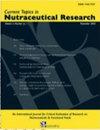皮肤类胡萝卜素评分作为预测中年人2型糖尿病的重要预后因素
IF 0.4
4区 医学
Q4 NUTRITION & DIETETICS
Current Topics in Nutraceutical Research
Pub Date : 2023-10-09
DOI:10.37290/ctnr2641-452x.21:373-379
引用次数: 0
摘要
本研究旨在通过无创皮肤类胡萝卜素和血管功能测量来识别有患2型糖尿病风险的中年受试者。为此,61名受试者(40-65岁)无2型糖尿病(A组,血红蛋白A1c <6.5%)和69名2型糖尿病患者(B组,血红蛋白A1c≥6.5%)(40-65岁)被招募(表1)。皮肤类胡萝卜素评分采用基于光谱的皮肤类胡萝卜素测量方法记录,近似于饮食中的水果和蔬菜摄入量。测量了两组的内皮功能和心率变异性,并与皮肤类胡萝卜素评分相关。两组每日蔬菜和水果摄入量与皮肤类胡萝卜素得分呈正相关(A组,r = 0.598, p <0.001;B组,r = 0.449, p <0.001)。A组和b组受试者在皮肤类胡萝卜素评分、内皮功能指数和心率变异性方面也存在显著差异。皮肤类胡萝卜素评分与代谢综合征的个体决定因素呈负相关,包括高密度脂蛋白(r = - 0.361, p = 0.009)、腰围(r = - 0.450, p <0.001),空腹血糖(r = - 0.713, p <0.001),血红蛋白A1c (r = - 0.808, p <0.001);而收缩压无显著相关性(p = 0.06)。综上所述,类胡萝卜素和心血管参数是中年人2型糖尿病的可靠预测因素。本文章由计算机程序翻译,如有差异,请以英文原文为准。
Skin Carotenoid Score as an Important Prognostic Factor for Predicting Type 2 Diabetes Mellitus in Middle-Aged Subjects
This study aimed at identifying middle-aged subjects at risk for developing type 2 diabetes mellitus using noninvasive skin carotenoid and vascular function measurements. To this end, 61 subjects (40–65 years of age) without type 2 diabetes mellitus (Group A, Hemoglobin A1c < 6.5%) and 69 subjects (40–65 years of age) with type 2 diabetes mellitus (Group B, Hemoglobin A1c ≥ 6.5%) were recruited (Table 1). The skin carotenoid score was recorded using spectroscopy-based skin carotenoid measurements that approximate dietary fruit and vegetable intake. Endothelial function and heart rate variability were measured for the two groups and correlated with skin carotenoids scores. The daily vegetable and fruit intake was positively correlated with the skin carotenoids score in both groups (Group A, r = 0.598, p < 0.001; Group B, r = 0.449, p < 0.001). There were also significant differences in skin carotenoids score, indices of endothelial function, and heart rate variability between the subjects in group A and group B. There was a negative correlation between skin carotenoids score and individual determinants of metabolic syndrome, including high-density lipoprotein (r = −0.361, p = 0.009), waist circumference (r = −0.450, p < 0.001), fasting blood sugar (r = −0.713, p < 0.001), and Hemoglobin A1c (r = −0.808, p < 0.001); however, systolic blood pressure showed no significant correlation (p = 0.06). In conclusion, carotenoids and cardiovascular parameters are reliable predictive factors of type 2 diabetes mellitus in middle-aged subjects.
求助全文
通过发布文献求助,成功后即可免费获取论文全文。
去求助
来源期刊
CiteScore
1.10
自引率
0.00%
发文量
36
审稿时长
>12 weeks
期刊介绍:
Current Topics in Nutraceutical Research is an international, interdisciplinary broad-based peer reviewed scientific journal for critical evaluation of research on chemistry, biology and therapeutic applications of nutraceuticals and functional foods. The major goal of this journal is to provide peer reviewed unbiased scientific data to the decision makers in the nutraceutical and food industry to help make informed choices about development of new products.
To this end, the journal will publish two types of review articles. First, a review of preclinical research data coming largely from animal, cell culture and other experimental models. Such data will provide basis for future product development and/or human research initiatives. Second, a critical evaluation of current human experimental data to help market and deliver the product for medically proven use. This journal will also serve as a forum for nutritionists, internists, neurologists, psychiatrists, and all those interested in preventive medicine.
The common denominator of all of the topic to be covered by the journal must include nutraceuticals and/functional food. The following is an example of some specific areas that may be of interest to the journal. i) Role of vitamins, minerals, antioxidants and phytonutrients on cardiovascular health, cancer, diabetes, ocular health, mental health, men’s health, women’s health, infant nutrition, ii) Role of herbals on human health, iii) Dietary supplements and sleep, iv) Components of diet that may have beneficial effect on human health, v) regulation of apoptosis and cell viability, vi) Isolation and characterization of bioactive components from functional foods, vii) Nutritional genomics, and viii) Nutritional proteomics.

 求助内容:
求助内容: 应助结果提醒方式:
应助结果提醒方式:


